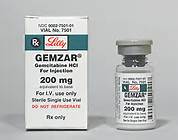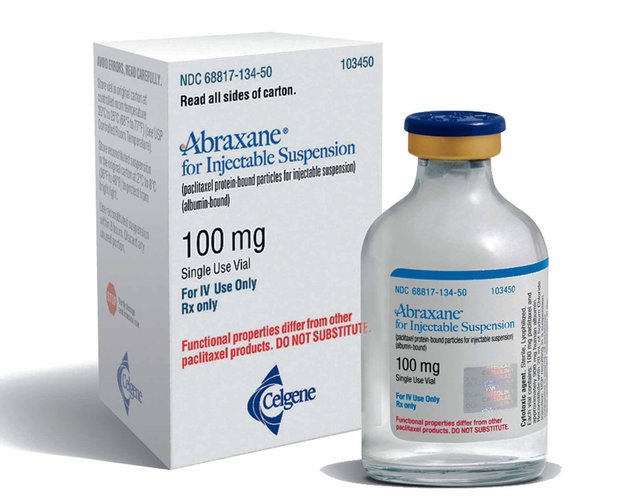Chemotherapy

There is generally one drug which is commonly used to treat pancreatic cancer and that is Gemcitabine (Gemzar®), It has international approval as a first-line treatment for people with advanced or metastatic disease.
Once pancreatic cancer has spread beyond the vicinity of the pancreas and involves other organs, a systemic treatment is most appropriate and chemotherapy is recommended.
Chemotherapy travels through the bloodstream and goes anywhere the blood flows. It can attack a cancer that has spread through the body wherever it is found.
National Survey for Patients, Survivors and Caregivers.- We thank everyone who participated in a recent survey and shared their experience with pancreatic cancer. The survey is being used as a Pancreatic Cancer Canada and Craig's Cause Pancreatic Cancer Society's Joint Patient Evidence Submission to the pan-Canadian Oncology Drug Review (pCODR). PCODR evaluates cancer drugs and makes recommendations to the provinces and territories to guide their drug funding decisions. Your participation will help pCODR understand the patient and caregiver perspectives concerning the experience and access to pancreatic cancer therapies. The drug that is currently under reveiw is Abraxane; it is currently approved in the US and Europe for treating metastatic pancreatic cancer.
3 Key Pancreatic Cancer Drugs to know in 2014 - Article in Daily Finance Jan 13/2014 by Leo Sun

Why is chemotherapy given to patients?
- To control the cancer and prolong a quality of life.
- To reduce the size of a cancer. Chemotherapy can be used to shrink the tumour in the pancreas before surgery or radiotherapy can be considered. This is called neo-adjuvant treatment.
- To try and prevent the cancer coming back after surgery or radiotherapy. The aim is to kill any cancer cells that are left. This is called adjuvant treatment.
- To increase the effectiveness of radiotherapy treatment. Chemotherapy can be used alongside radiotherapy to increase the chance of treatment being more effective and is called chemo-radiotherapy.
How does chemotherapy affect my day to day?

Chemotherapy affects people in different ways and some people are able to carry on as normal.
If there is a special occasion that you would like to attend, or you want to go on holiday, it may be possible to arrange the timing of your treatment to suit. Your oncologist can tell you whether this is possible.
Many people do feel tired during and after chemotherapy. For those who are recovering from surgery or having radiotherapy, you may feel extremely tired. If this happens to you, it is important to slow down on the things you don’t really need to do.
There is some evidence that exercise, of low to moderate intensity, may substantially help this tiredness. Do as much as you think you can manage and get enough rest and sleep.
Chemotherapy drugs used to treat pancreatic cancer
Gemcitibine (also know as Gemzar®)
Gemcitabine is commonly used to treat pancreatic cancer. It is a colourless fluid, which is usually given by intravenous infusion (through a drip) with each infusion usually lasting around 30 minutes. You will often be given anti-sickness drugs at the same time.
Intravenous infusions are given through a thin, short tube put into a vein in your arm each time you have treatment. Alternatively, you may have a central line, a portacath or a PICC line inserted just before your treatment starts. These are tubes that give the drugs directly into a large vein in your chest and will stay in place as long as you need them.
Usually the side effects of Gemcitabine are relatively mild and may include:
- Fatigue (tiredness)
- Swelling of feet/legs due to fluid retention
- A drop in blood cells
- Nausea and/or vomiting
- Flu-like symptoms (aching muscles, headache, chills)
- Skin rash
- Hair thinning (it’s rare for it to completely fall out)
- Diarrhea
- Constipation
- Mouth sores
Folfirinox
FOLFIRINOX is a new treatment for metastatic pancreatic cancer consisting of three chemotherapy agents. In a large randomized phase III study, it demonstrated a survival benefit over the standard treatment of gemcitabine. It started as a clinical trial where a combination of the chemotherapy drugs fluorouracil [5-FU], leucovorin, irinotecan and oxaliplatin and the standard single-drug treatment, gemcitabine. were given to patients with metastatic pancreatic cancer.
Results from the study (New England Journal of Medicine) presenting at ASCO 2010, reported 48% of patients on FOLFIRINOX were alive after 1 year compared to 20% on gemcitabine and, for the first time in a study involving patients with metastatic pancreatic cancer, a median overall survival of 11.1 months was obtained.
Unfortunately, it is unlikely to be the "magic bullet" we are all hoping for as it is not recommended for all patients as it is an extremely toxic treatment. Currently, it is only proven to be beneficial in patients with metastatic pancreas cancer (Stage 4) who have not yet received any chemotherapy.
Side Effects:
- Increased risk of an infection due to a drop in white blood cells
- Tiredness and breathlessness due to a drop in red blood cells
- Some liver changes
- Mouth sores or ulcers
- Diarrhea
- Skin itching
- Red, sore peeling hands or soles of feet
- Bruising more easily due to a drop in platelets also you may have bleeding gums, nosebleeds or tiny red spots known as petechial.
Folfirinox is currently available in cancer centres across Canada
Abraxane
Abraxane® (also known as nab-paclitaxel) has been used in combination with gemcitabine within clinical trials and a recent phase III randomised trial and has showed that nab-pactlitaxel plus gemcitabine was superior to gemcitabine alone.
Abraxane (an albumin-bound nanoparticle formulation of paclitaxel) depletes surrounding stroma and will kill cancer cells but crutially it also produces molecules that block an enzyme called cytidine deaminase (CDA). This molecule normally destroys the drug gemcitabine. So, by using Abraxane in conjunction with gemcitabine, the amount of gemcitabine getting into the tumours is increased thereby making it much more effective.
It is currently approved by the Food and Drug Adminstration (FDA) for treatment of advanced pancreatic cancer in the United States and in early 2014 by the European Union (UN).
Breaking News (April 2015) - funding for Abraxane has been approved in the majority of provinces across Canada. Quebec is the exception - it is currently under review but is available as a treatment option att major cancer centres..
Side Effects:
- Decreased blood cell counts. Abraxane® can cause a severe decrease in neutrophils (a type of white blood cells important in fighting in bacterial infections) and platelets (important for clotting and to control bleeding).
- Numbness, tingling, or burning in your hands or feet (neuropathy).
- Diarrhea
- Hair loss
- Muscle and join pain
- Tiredness
- Nausea
- Blood Clots
- Swallowing
5-Fluorouracil (5-FU)
5-Fluorouracil (5-FU) is a liquid, which is administered intravenously (through a drip). Sometimes a vitamin called folinic acid is given at the same time as this helps the chemotherapy drug work better.You will often be given anti-sickness drugs (anti-emetics) at the same time.
Side effects are:
- A drop in blood cells
- Mouth Ulcers and/or sore mouth
- Diarrhea
- Skin changes due to excess production of pigment
- Fatigue (tiredness)
- Being or feeling sick
- Greater sensitivity to sunlight
- Hair thinning
- Chipped, brittle and ridged nails
- Loss of appetite
Drug Combinations and Targeted Therapies
Combinations of pancreatic cancer chemotherapy drugs and other agents are currently being used as part of clinical trials.
- In some instances, gemcitabine has been given with other platinum-based drugs such as Cisplatin or Oxaliplatin (Eloxatin® ). These drugs contain an atom of the metal platinum. The drug forms DNA cross links via the platinum which damage the cancer cells.
- Gemcitabine has also been used along with a biological therapy, erlotinib (Tarceva®). Used in trials for people with metastatic (spread to other parts of the body) pancreatic cancer, erlotinib works by interfering with the way that cancer cells grow and divide.
Targeted cancer therapies are drugs or other substances that block the growth and spread of cancer by interfering with specific molecules involved in tumor growth and progression. Erlotinib (Tarceva) is one of the newer targeted therapies that can be helpful in selected patients and is approved in many countries for the treatment of pancreatic cancer. Other drugs used include 5-fluoro-uracil (5FU), irinotecan and oxaliplatin.
The Future
 Many researchers say the path forward is to go from targeted therapy for pancreatic cancer to a personalized therapy based in the genetic profile of the tumor. There is already some significant progress in other types of cancer when tumor samples from patients are tested for certain genetic mutations. In specific cases, the results help to influence the choice of therapy with very promising results.
Many researchers say the path forward is to go from targeted therapy for pancreatic cancer to a personalized therapy based in the genetic profile of the tumor. There is already some significant progress in other types of cancer when tumor samples from patients are tested for certain genetic mutations. In specific cases, the results help to influence the choice of therapy with very promising results.
With pancreatic cancer expression of a gene called ATDC is on average 20 times higher in pancreatic cancer cells than in cells from a normal pancreas. Interesting new research has shown that ATDC not only causes the cancer cells to grow faster and be more aggressive but also makes the cancer cells resistant to chemotherapy and radiation. By targeting this gene, scientists might be able to make cancer cells more sensitive to the existing cancer therapies that have been already developed.











 Many researchers say the path forward is to go from targeted therapy for pancreatic cancer to a personalized therapy based in the genetic profile of the tumor. There is already some significant progress in other types of cancer when tumor samples from patients are tested for certain genetic mutations. In specific cases, the results help to influence the choice of therapy with very promising results.
Many researchers say the path forward is to go from targeted therapy for pancreatic cancer to a personalized therapy based in the genetic profile of the tumor. There is already some significant progress in other types of cancer when tumor samples from patients are tested for certain genetic mutations. In specific cases, the results help to influence the choice of therapy with very promising results.